Deep and Machine Learning Models to Forecast Photovoltaic Power Generation
Abstract
1. Introduction
Key Contributions
- Firstly, this study provides a comprehensive benchmark comparison of seven models (extreme gradient boosting algorithm (XGB), support vector regressor (SVR), random forest (RF), classic multi-layer perceptron (MLP), and LSTM-based models) that forecast 15 min, 30 min, and 1 h ahead of residential PV power production considering data availability constraints (i.e., only a small amount of PV power production data and limited PV capacity (lower than 2 kW)) and a scalability analysis from a techno-economic perspective.
- Subsequently, we introduce a model based on stacked ConvLSTM1D layers that has been used in various energy-related prediction applications based on one-dimensional time-series forecasts. The performance of this model is benchmarked against other forecasting models that share operational similarities, such as LSTM-based models.
- Lastly, this study discusses some issues of the analyzed forecasting models and evaluates their usefulness for the development of new computational decision-making tools for the effective management and integration of this type of DER.
2. Methodology
2.1. Dataset Preparation
2.2. ML and DL Model Development
2.2.1. Extreme Gradient Boosting Algorithm (XGB)
2.2.2. Support Vector Machine: Regression (SVR)
2.2.3. Random Forest (RF)
2.2.4. Multi-Layer Perceptron (MLP)
2.2.5. LSTM-Based Models
2.2.6. ConvLSTM
2.3. Assessment of Forecasting Accuracy
3. Results and Discussion
3.1. Exploratory Data Analysis
3.2. Hyperparameter Tuning
3.3. Model Performance Benchmarking and Analysis
3.3.1. Technical Perspective
3.3.2. Economical Perspective
4. Conclusions
Author Contributions
Funding
Acknowledgments
Conflicts of Interest
References
- Restrepo-Trujillo, J.; Moreno-Chuquen, R.; Jiménez-García, F.; Chamorro, H.R. Scenario Analysis of an Electric Power System in Colombia Considering the El Niño Phenomenon and the Inclusion of Renewable Energies. Energies 2022, 15, 6690. [Google Scholar] [CrossRef]
- Ufa, R.; Malkova, Y.; Rudnik, V.; Andreev, M.; Borisov, V. A review on distributed generation impacts on electric power system. Int. J. Hydrogen Energy 2022, 47, 20347–20361. [Google Scholar] [CrossRef]
- Cantillo-Luna, S.; Moreno-Chuquen, R.; Chamorro, H.R.; Sood, V.K.; Badsha, S.; Konstantinou, C. Blockchain for Distributed Energy Resources Management and Integration. IEEE Access 2022, 10, 68598–68617. [Google Scholar] [CrossRef]
- Burger, S.P.; Luke, M. Business models for distributed energy resources: A review and empirical analysis. Energy Policy 2017, 109, 230–248. [Google Scholar] [CrossRef]
- Zaouali, K.; Rekik, R.; Bouallegue, R. Deep learning forecasting based on auto-lstm model for home solar power systems. In Proceedings of the 2018 IEEE 20th International Conference on High Performance Computing and Communications, IEEE 16th International Conference on Smart City; IEEE 4th International Conference on Data science and Systems (HPCC/SmartCity/DSS), Exeter, UK, 28–30 June 2018; pp. 235–242. [Google Scholar]
- Wang, K.; Qi, X.; Liu, H. A comparison of day-ahead photovoltaic power forecasting models based on deep learning neural network. Appl. Energy 2019, 251, 113315. [Google Scholar] [CrossRef]
- Akhter, M.N.; Mekhilef, S.; Mokhlis, H.; Mohamed Shah, N. Review on forecasting of photovoltaic power generation based on machine learning and metaheuristic techniques. IET Renew. Power Gener. 2019, 13, 1009–1023. [Google Scholar] [CrossRef]
- Hafiz, F.; Awal, M.; de Queiroz, A.R.; Husain, I. Real-time stochastic optimization of energy storage management using deep learning-based forecasts for residential PV applications. IEEE Trans. Ind. Appl. 2020, 56, 2216–2226. [Google Scholar] [CrossRef]
- Rajagukguk, R.A.; Ramadhan, R.A.; Lee, H.J. A review on deep learning models for forecasting time series data of solar irradiance and photovoltaic power. Energies 2020, 13, 6623. [Google Scholar] [CrossRef]
- Santhosh, M.; Venkaiah, C.; Vinod Kumar, D. Current advances and approaches in wind speed and wind power forecasting for improved renewable energy integration: A review. Eng. Rep. 2020, 2, e12178. [Google Scholar] [CrossRef]
- Gupta, P.; Singh, R. PV power forecasting based on data-driven models: A review. Int. J. Sustain. Eng. 2021, 14, 1733–1755. [Google Scholar] [CrossRef]
- Massaoudi, M.; Chihi, I.; Abu-Rub, H.; Refaat, S.S.; Oueslati, F.S. Convergence of photovoltaic power forecasting and deep learning: State-of-art review. IEEE Access 2021, 9, 136593–136615. [Google Scholar] [CrossRef]
- Tina, G.M.; Ventura, C.; Ferlito, S.; De Vito, S. A state-of-art-review on machine-learning based methods for PV. Appl. Sci. 2021, 11, 7550. [Google Scholar] [CrossRef]
- Costa, R.L.D.C. Convolutional-LSTM networks and generalization in forecasting of household photovoltaic generation. Eng. Appl. Artif. Intell. 2022, 116, 105458. [Google Scholar] [CrossRef]
- Essam, Y.; Ahmed, A.N.; Ramli, R.; Chau, K.W.; Idris Ibrahim, M.S.; Sherif, M.; Sefelnasr, A.; El-Shafie, A. Investigating photovoltaic solar power output forecasting using machine learning algorithms. Eng. Appl. Comput. Fluid Mech. 2022, 16, 2002–2034. [Google Scholar] [CrossRef]
- Gaviria, J.F.; Narváez, G.; Guillen, C.; Giraldo, L.F.; Bressan, M. Machine learning in photovoltaic systems: A review. Renew. Energy 2022, 196, 298–318. [Google Scholar] [CrossRef]
- Zhao, E.; Sun, S.; Wang, S. New developments in wind energy forecasting with artificial intelligence and big data: A scientometric insight. Data Sci. Manag. 2022, 5, 84–95. [Google Scholar] [CrossRef]
- Markovics, D.; Mayer, M.J. Comparison of machine learning methods for photovoltaic power forecasting based on numerical weather prediction. Renew. Sustain. Energy Rev. 2022, 161, 112364. [Google Scholar] [CrossRef]
- Shabbir, N.; Kütt, L.; Raja, H.A.; Jawad, M.; Allik, A.; Husev, O. Techno-economic analysis and energy forecasting study of domestic and commercial photovoltaic system installations in Estonia. Energy 2022, 253, 124156. [Google Scholar] [CrossRef]
- Luo, Z.; Peng, J.; Tan, Y.; Yin, R.; Zou, B.; Hu, M.; Yan, J. A novel forecast-based operation strategy for residential PV-battery-flexible loads systems considering the flexibility of battery and loads. Energy Convers. Manag. 2023, 278, 116705. [Google Scholar] [CrossRef]
- Phinikarides, A.; Makrides, G.; Kindyni, N.; Kyprianou, A.; Georghiou, G.E. ARIMA modeling of the performance of different photovoltaic technologies. In Proceedings of the 2013 IEEE 39th Photovoltaic Specialists Conference (PVSC), Tampa, FL, USA, 16–21 June 2013; pp. 797–801. [Google Scholar]
- Dong, Z.; Yang, D.; Reindl, T.; Walsh, W.M. Short-term solar irradiance forecasting using exponential smoothing state space model. Energy 2013, 55, 1104–1113. [Google Scholar] [CrossRef]
- Li, Y.; Su, Y.; Shu, L. An ARMAX model for forecasting the power output of a grid connected photovoltaic system. Renew. Energy 2014, 66, 78–89. [Google Scholar] [CrossRef]
- Raza, M.Q.; Nadarajah, M.; Ekanayake, C. On recent advances in PV output power forecast. Sol. Energy 2016, 136, 125–144. [Google Scholar] [CrossRef]
- Sobri, S.; Koohi-Kamali, S.; Rahim, N.A. Solar photovoltaic generation forecasting methods: A review. Energy Convers. Manag. 2018, 156, 459–497. [Google Scholar] [CrossRef]
- Atique, S.; Noureen, S.; Roy, V.; Subburaj, V.; Bayne, S.; Macfie, J. Forecasting of total daily solar energy generation using ARIMA: A case study. In Proceedings of the 2019 IEEE 9th annual computing and communication workshop and conference (CCWC), Las Vegas, NV, USA, 7–9 January 2019; pp. 114–119. [Google Scholar]
- Assouline, D.; Mohajeri, N.; Scartezzini, J.L. Quantifying rooftop photovoltaic solar energy potential: A machine learning approach. Sol. Energy 2017, 141, 278–296. [Google Scholar] [CrossRef]
- Preda, S.; Oprea, S.V.; Bâra, A.; Belciu, A. PV forecasting using support vector machine learning in a big data analytics context. Symmetry 2018, 10, 748. [Google Scholar] [CrossRef]
- Ahmad, M.W.; Mourshed, M.; Rezgui, Y. Tree-based ensemble methods for predicting PV power generation and their comparison with support vector regression. Energy 2018, 164, 465–474. [Google Scholar] [CrossRef]
- Huertas Tato, J.; Centeno Brito, M. Using smart persistence and random forests to predict photovoltaic energy production. Energies 2018, 12, 100. [Google Scholar] [CrossRef]
- Zhu, R.; Guo, W.; Gong, X. Short-term photovoltaic power output prediction based on k-fold cross-validation and an ensemble model. Energies 2019, 12, 1220. [Google Scholar] [CrossRef]
- Munawar, U.; Wang, Z. A framework of using machine learning approaches for short-term solar power forecasting. J. Electr. Eng. Technol. 2020, 15, 561–569. [Google Scholar] [CrossRef]
- Phan, Q.T.; Wu, Y.K.; Phan, Q.D. Short-term Solar Power Forecasting Using XGBoost with Numerical Weather Prediction. In Proceedings of the 2021 IEEE International Future Energy Electronics Conference (IFEEC), Taipei, Taiwan, 16–19 November 2021. [Google Scholar] [CrossRef]
- Wang, Y.; Liao, W.; Chang, Y. Gated recurrent unit network-based short-term photovoltaic forecasting. Energies 2018, 11, 2163. [Google Scholar] [CrossRef]
- Lee, D.; Jeong, J.; Yoon, S.H.; Chae, Y.T. Improvement of short-term BIPV power predictions using feature engineering and a recurrent neural network. Energies 2019, 12, 3247. [Google Scholar] [CrossRef]
- Hossain, M.S.; Mahmood, H. Short-term photovoltaic power forecasting using an LSTM neural network and synthetic weather forecast. IEEE Access 2020, 8, 172524–172533. [Google Scholar] [CrossRef]
- Ahn, H.K.; Park, N. Deep RNN-based photovoltaic power short-term forecast using power IoT sensors. Energies 2021, 14, 436. [Google Scholar] [CrossRef]
- Khan, W.; Walker, S.; Zeiler, W. Improved solar photovoltaic energy generation forecast using deep learning-based ensemble stacking approach. Energy 2022, 240, 122812. [Google Scholar] [CrossRef]
- Ghimire, S.; Deo, R.C.; Raj, N.; Mi, J. Deep solar radiation forecasting with convolutional neural network and long short-term memory network algorithms. Appl. Energy 2019, 253, 113541. [Google Scholar] [CrossRef]
- Suresh, V.; Janik, P.; Rezmer, J.; Leonowicz, Z. Forecasting solar PV output using convolutional neural networks with a sliding window algorithm. Energies 2020, 13, 723. [Google Scholar] [CrossRef]
- Tovar, M.; Robles, M.; Rashid, F. PV power prediction, using CNN-LSTM hybrid neural network model. Case of study: Temixco-Morelos, México. Energies 2020, 13, 6512. [Google Scholar] [CrossRef]
- Agga, A.; Abbou, A.; Labbadi, M.; El Houm, Y.; Ali, I.H.O. CNN-LSTM: An efficient hybrid deep learning architecture for predicting short-term photovoltaic power production. Electr. Power Syst. Res. 2022, 208, 107908. [Google Scholar] [CrossRef]
- Zhou, H.; Zhang, Y.; Yang, L.; Liu, Q.; Yan, K.; Du, Y. Short-term photovoltaic power forecasting based on long short term memory neural network and attention mechanism. IEEE Access 2019, 7, 78063–78074. [Google Scholar] [CrossRef]
- Wang, F.; Zhang, Z.; Liu, C.; Yu, Y.; Pang, S.; Duić, N.; Shafie-Khah, M.; Catalao, J.P. Generative adversarial networks and convolutional neural networks based weather classification model for day ahead short-term photovoltaic power forecasting. Energy Convers. Manag. 2019, 181, 443–462. [Google Scholar] [CrossRef]
- Perera, M.; De Hoog, J.; Bandara, K.; Halgamuge, S. Multi-resolution, multi-horizon distributed solar PV power forecasting with forecast combinations. Expert Syst. Appl. 2022, 205, 117690. [Google Scholar] [CrossRef]
- Grzebyk, D.; Alcañiz, A.; Donker, J.C.; Zeman, M.; Ziar, H.; Isabella, O. Individual yield nowcasting for residential PV systems. Sol. Energy 2023, 251, 325–336. [Google Scholar] [CrossRef]
- Chen, T.; Guestrin, C. Xgboost: A scalable tree boosting system. In Proceedings of the 22nd ACM SIGKDD International Conference on Knowledge Discovery and Data Mining, San Francisco, CA, USA, 13–17 August 2016; pp. 785–794. [Google Scholar]
- Nielsen, D. Tree Boosting with Xgboost-Why Does Xgboost Win “Every” Machine Learning Competition? Master’s Thesis, Norwegian University of Science and Technology, Trondheim, Norway, 2016. [Google Scholar]
- Xu, S.; An, X.; Qiao, X.; Zhu, L.; Li, L. Multi-output least-squares support vector regression machines. Pattern Recognit. Lett. 2013, 34, 1078–1084. [Google Scholar] [CrossRef]
- Ahmad, W.; Ayub, N.; Ali, T.; Irfan, M.; Awais, M.; Shiraz, M.; Glowacz, A. Towards Short Term Electricity Load Forecasting Using Improved Support Vector Machine and Extreme Learning Machine. Energies 2020, 13, 2907. [Google Scholar] [CrossRef]
- Das, U.K.; Tey, K.S.; Seyedmahmoudian, M.; Idna Idris, M.Y.; Mekhilef, S.; Horan, B.; Stojcevski, A. SVR-based model to forecast PV power generation under different weather conditions. Energies 2017, 10, 876. [Google Scholar] [CrossRef]
- Cantillo-Luna, S.; Moreno-Chuquen, R.; Chamorro, H.R.; Riquelme-Dominguez, J.M.; Gonzalez-Longatt, F. Locational Marginal Price Forecasting Using SVR-Based Multi-Output Regression in Electricity Markets. Energies 2022, 15, 293. [Google Scholar] [CrossRef]
- Hong, W.C.; Fan, G.F. Hybrid Empirical Mode Decomposition with Support Vector Regression Model for Short Term Load Forecasting. Energies 2019, 12, 1093. [Google Scholar] [CrossRef]
- Fu, T.; Zhang, S.; Wang, C. Application and research for electricity price forecasting system based on multi-objective optimization and sub-models selection strategy. Soft Comput. 2020, 24, 15611–15637. [Google Scholar] [CrossRef]
- Majidpour, M.; Nazaripouya, H.; Chu, P.; Pota, H.R.; Gadh, R. Fast univariate time series prediction of solar power for real-time control of energy storage system. Forecasting 2018, 1, 107–120. [Google Scholar] [CrossRef]
- Wang, J.; Li, P.; Ran, R.; Che, Y.; Zhou, Y. A short-term photovoltaic power prediction model based on the gradient boost decision tree. Appl. Sci. 2018, 8, 689. [Google Scholar] [CrossRef]
- Hornik, K.; Stinchcombe, M.; White, H. Multilayer feedforward networks are universal approximators. Neural Netw. 1989, 2, 359–366. [Google Scholar] [CrossRef]
- Haykin, S. Neural Networks and Learning Machines, 3/E; Pearson Education: Noida, India, 2009. [Google Scholar]
- Wang, F.; Xuan, Z.; Zhen, Z.; Li, K.; Wang, T.; Shi, M. A day-ahead PV power forecasting method based on LSTM-RNN model and time correlation modification under partial daily pattern prediction framework. Energy Convers. Manag. 2020, 212, 112766. [Google Scholar] [CrossRef]
- Hochreiter, S.; Schmidhuber, J. Long short-term memory. Neural Comput. 1997, 9, 1735–1780. [Google Scholar] [CrossRef]
- Liu, Y.; Guan, L.; Hou, C.; Han, H.; Liu, Z.; Sun, Y.; Zheng, M. Wind power short-term prediction based on LSTM and discrete wavelet transform. Appl. Sci. 2019, 9, 1108. [Google Scholar] [CrossRef]
- Pourdaryaei, A.; Mokhlis, H.; Illias, H.A.; Kaboli, S.H.A.; Ahmad, S.; Ang, S.P. Hybrid ANN and Artificial Cooperative Search Algorithm to Forecast Short-Term Electricity Price in De-Regulated Electricity Market. IEEE Access 2019, 7, 125369–125386. [Google Scholar] [CrossRef]
- Azam, M.F.; Younis, S. Multi-Horizon Electricity Load and Price Forecasting using an Interpretable Multi-Head Self-Attention and EEMD-Based Framework. IEEE Access 2021, 9, 85918–85932. [Google Scholar] [CrossRef]
- Ağbulut, Ü.; Gürel, A.E.; Ergün, A.; Ceylan, İ. Performance assessment of a V-Trough photovoltaic system and prediction of power output with different machine learning algorithms. J. Clean. Prod. 2020, 268, 122269. [Google Scholar] [CrossRef]
- Jiang, L.; Hu, G. A Review on Short-Term Electricity Price Forecasting Techniques for Energy Markets. In Proceedings of the 15th International Conference on Control, Automation, Robotics and Vision (ICARCV), Singapore, 18–21 November 2018. [Google Scholar] [CrossRef]
- Hong, Y.Y.; Taylar, J.V.; Fajardo, A.C. Locational marginal price forecasting in a day-ahead power market using spatiotemporal deep learning network. Sustain. Energy Grids Netw. 2020, 24, 100406. [Google Scholar] [CrossRef]
- Pedregosa, F.; Varoquaux, G.; Gramfort, A.; Michel, V.; Thirion, B.; Grisel, O.; Blondel, M.; Prettenhofer, P.; Weiss, R.; Dubourg, V.; et al. Scikit-learn: Machine Learning in Python. J. Mach. Learn. Res. 2011, 12, 2825–2830. [Google Scholar]
- Chollet, F. Keras. 2015. Available online: https://github.com/fchollet/keras (accessed on 25 January 2023).
- Gulli, A.; Pal, S. Deep Learning with Keras; Packt Publishing Ltd.: Birmingham, UK, 2017. [Google Scholar]
- Rachmatullah, M.I.C.; Santoso, J.; Surendro, K. A novel approach in determining neural networks architecture to classify data with large number of attributes. IEEE Access 2020, 8, 204728–204743. [Google Scholar] [CrossRef]
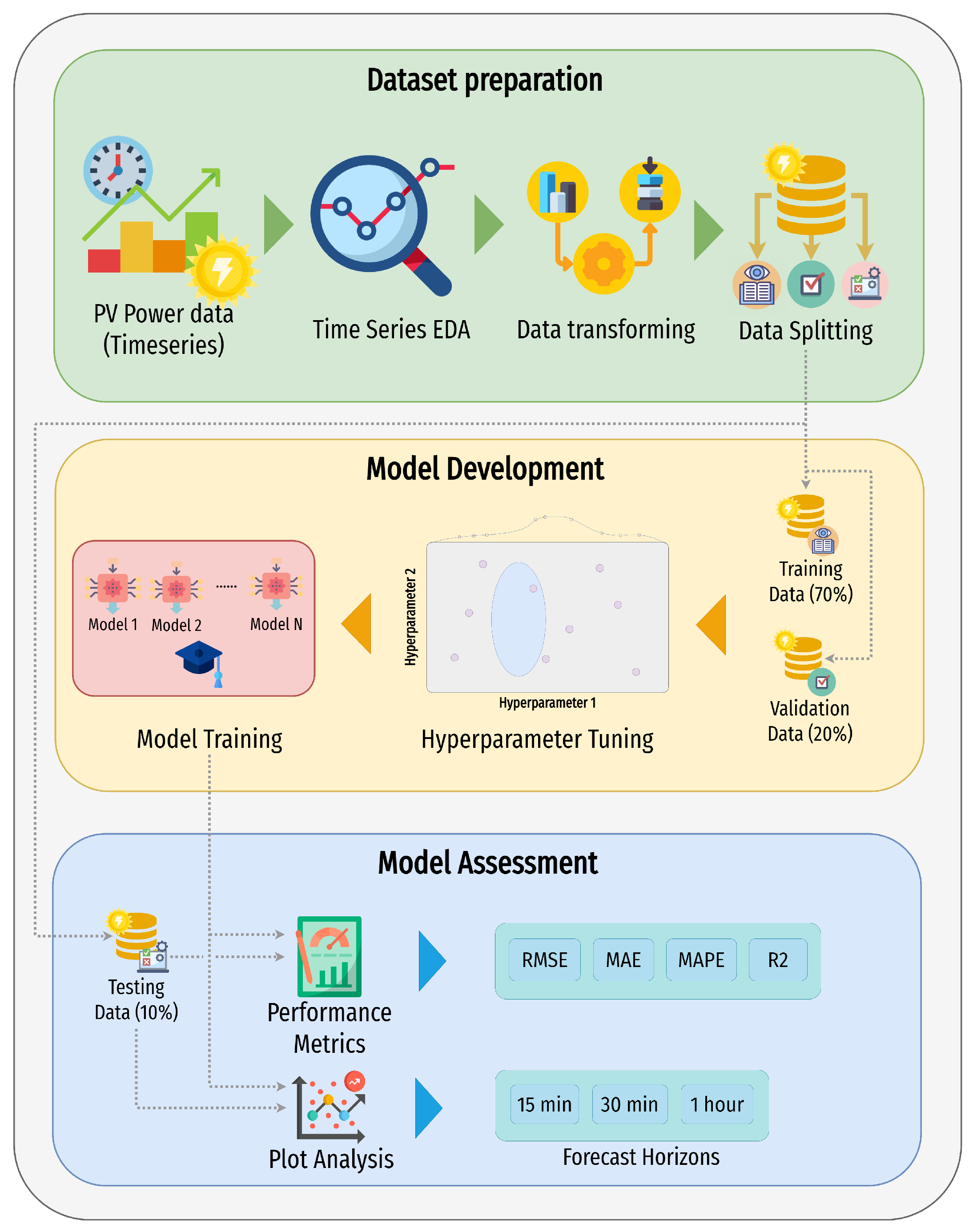
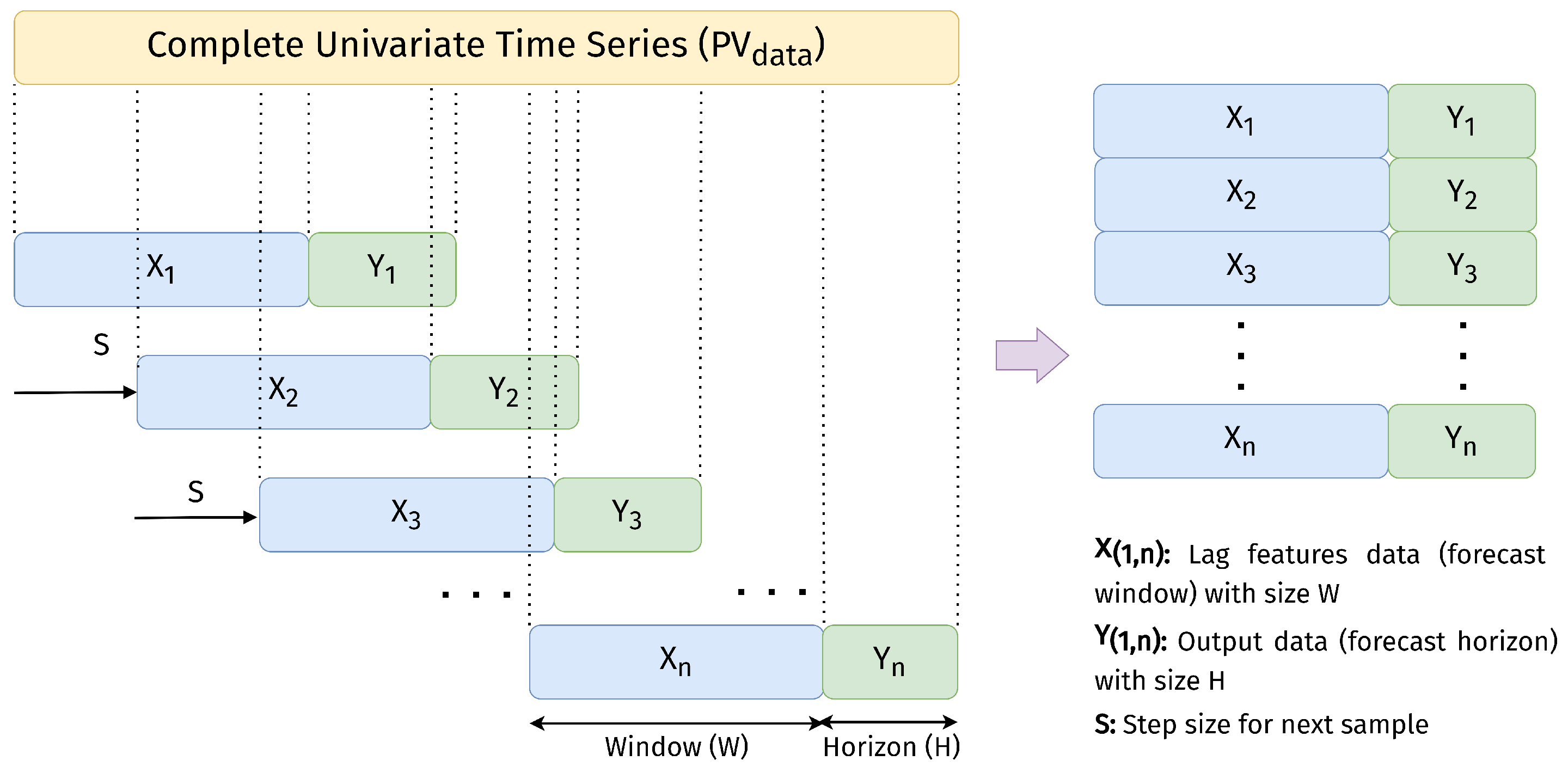
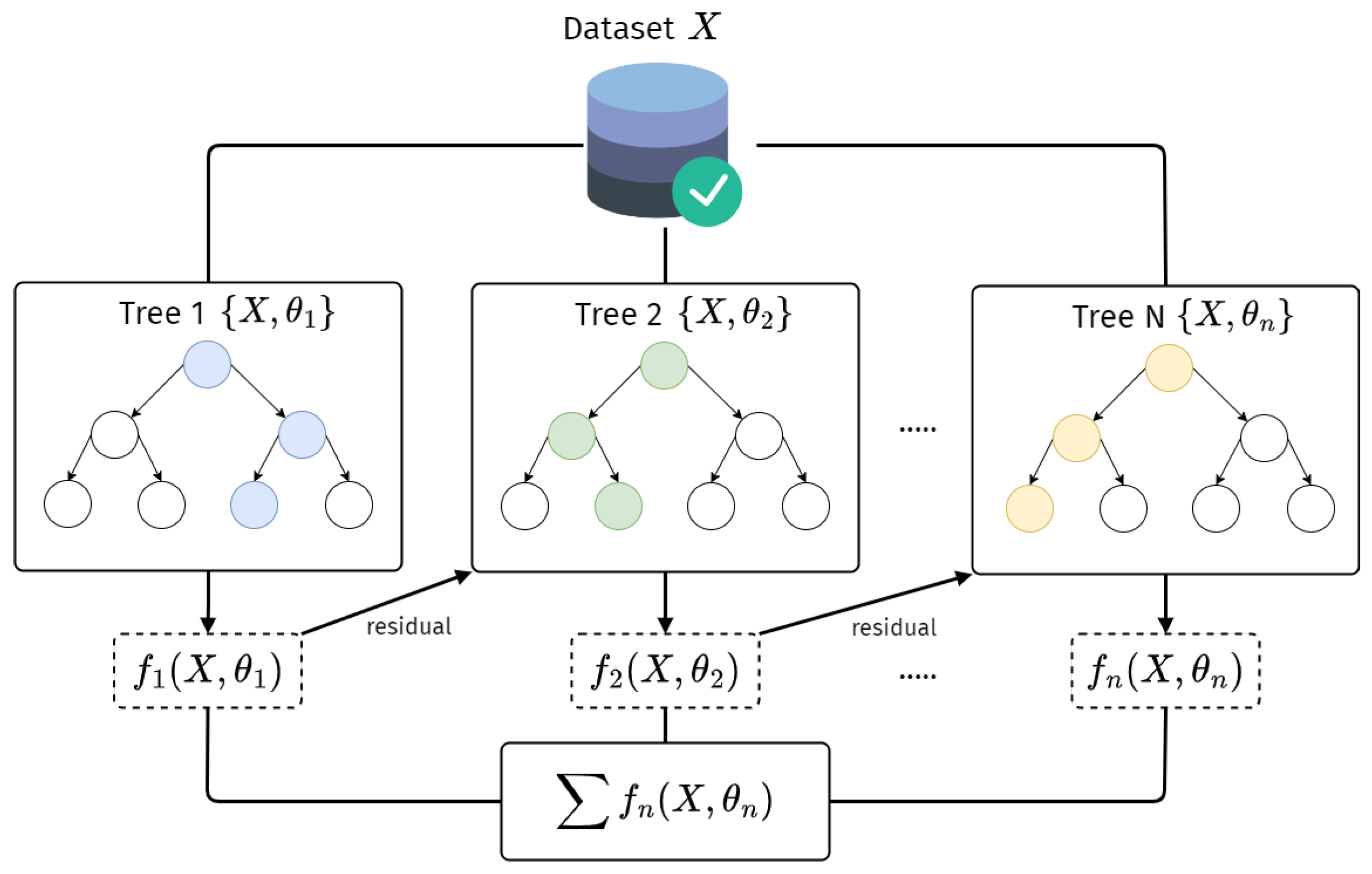
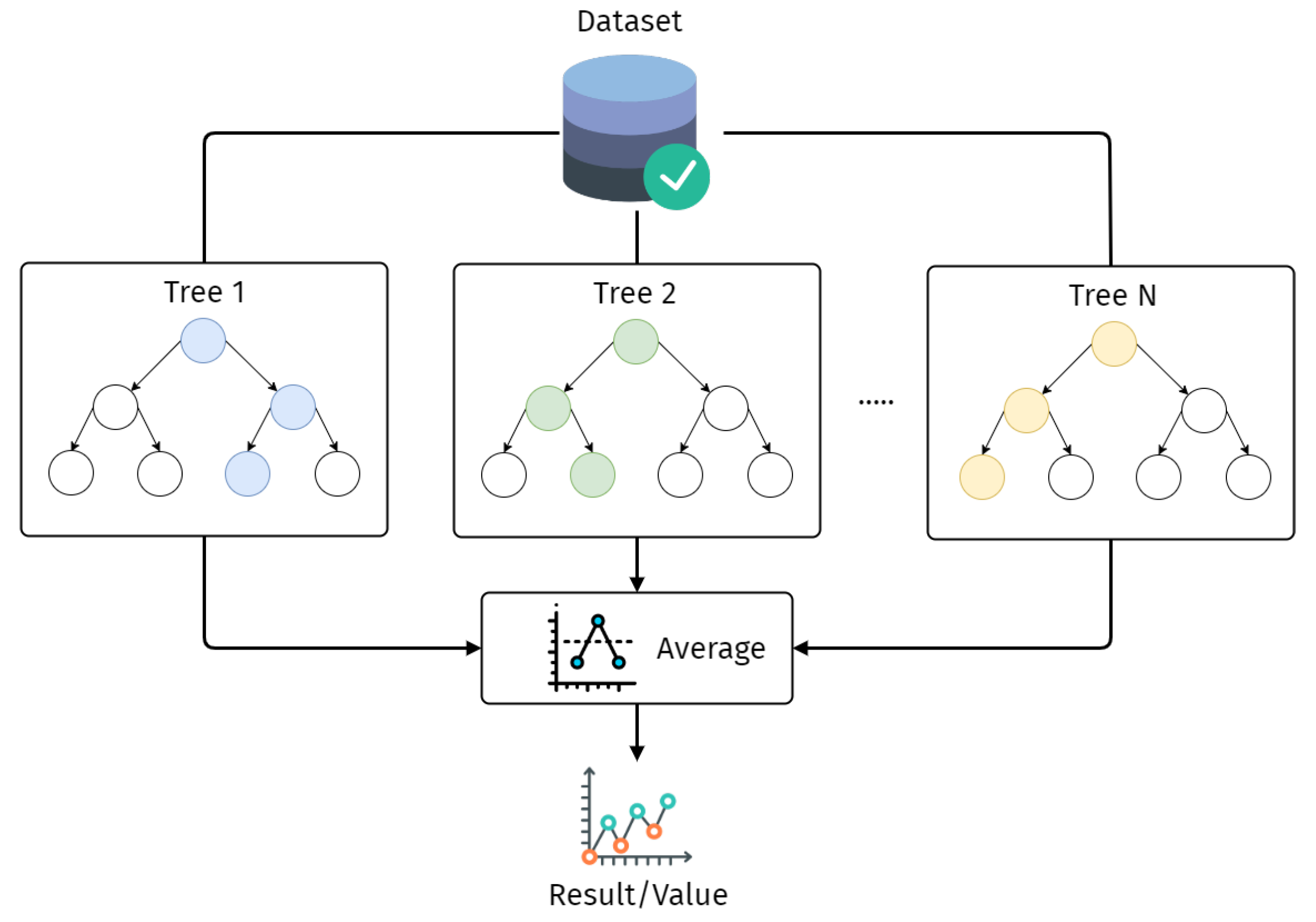
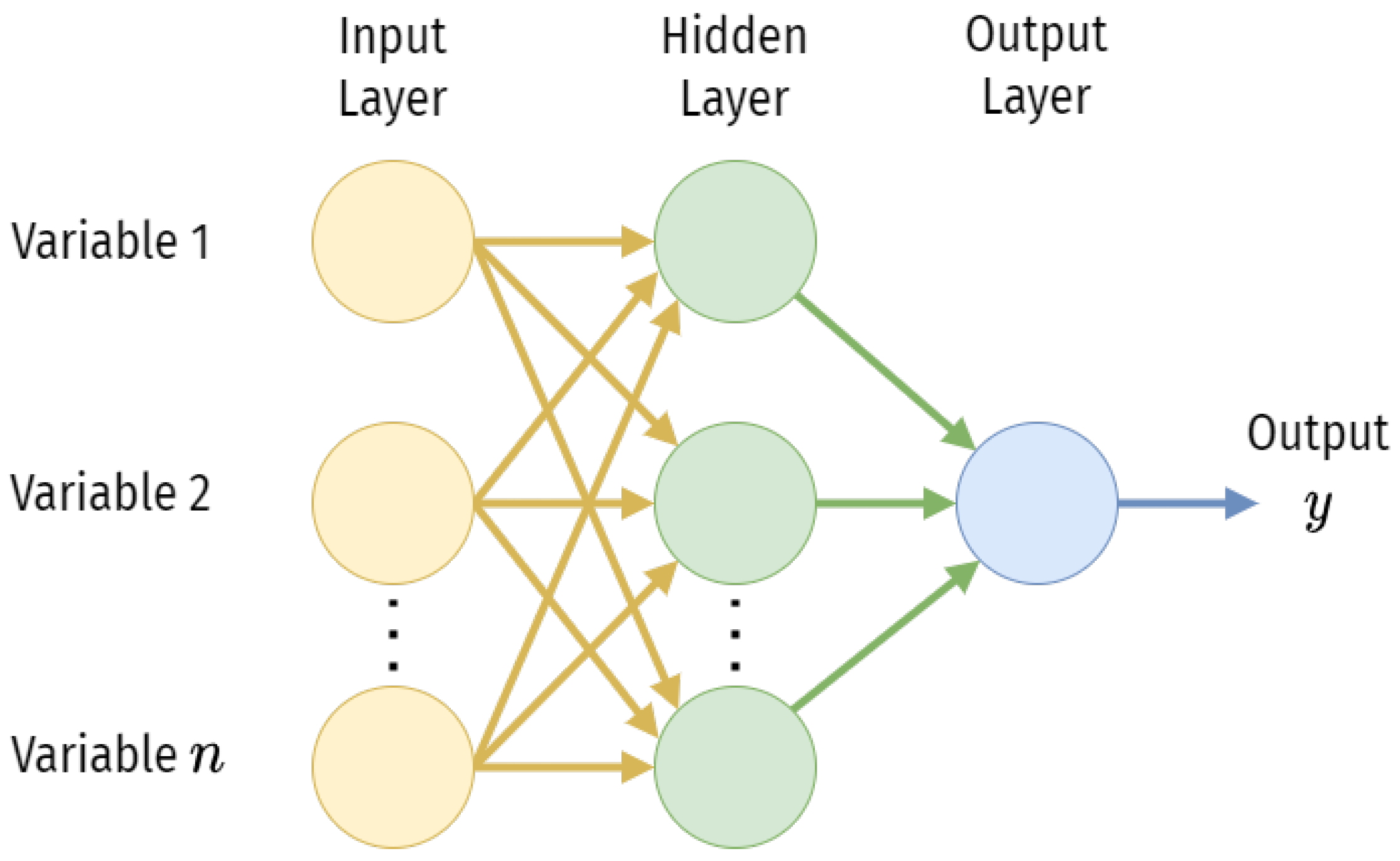
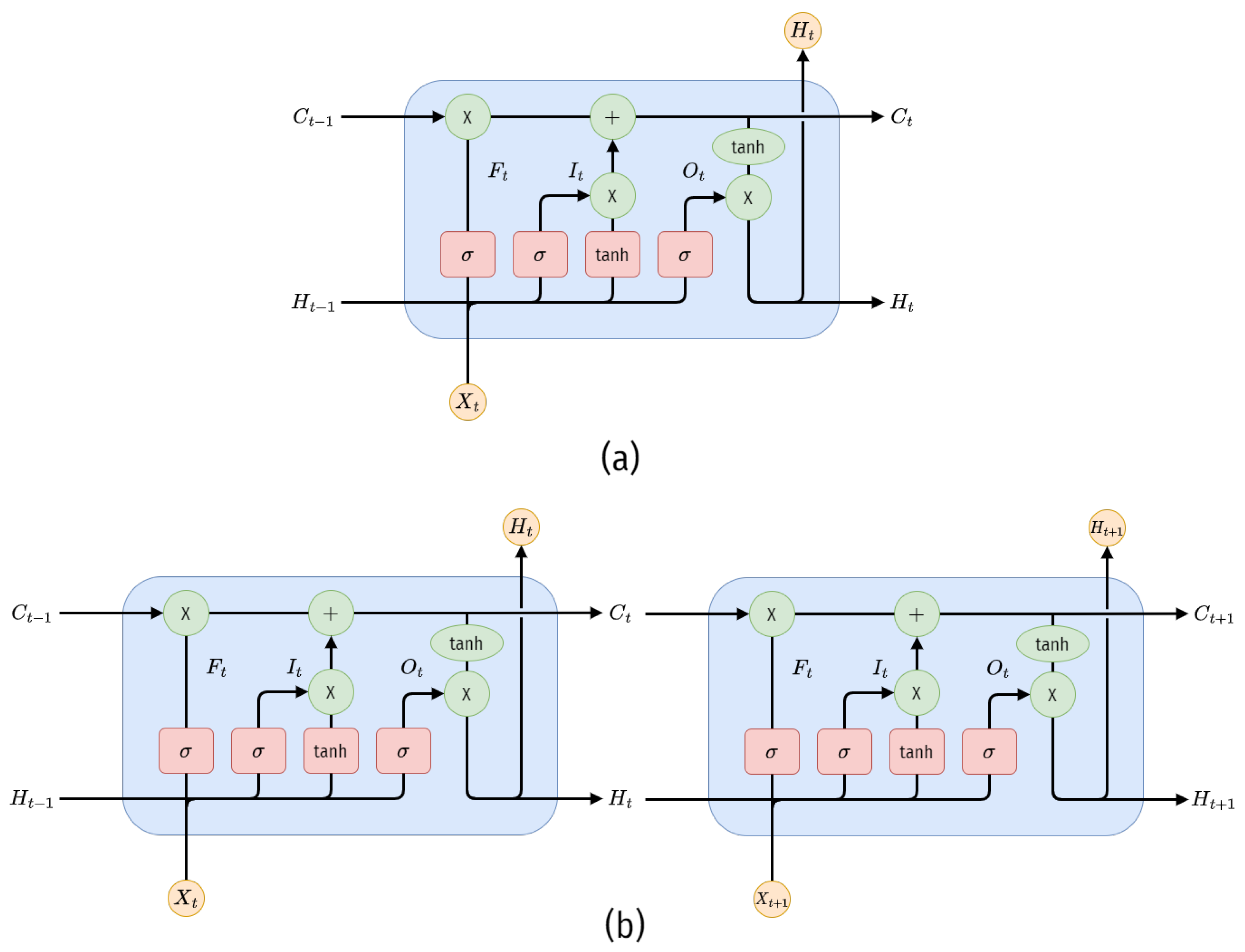
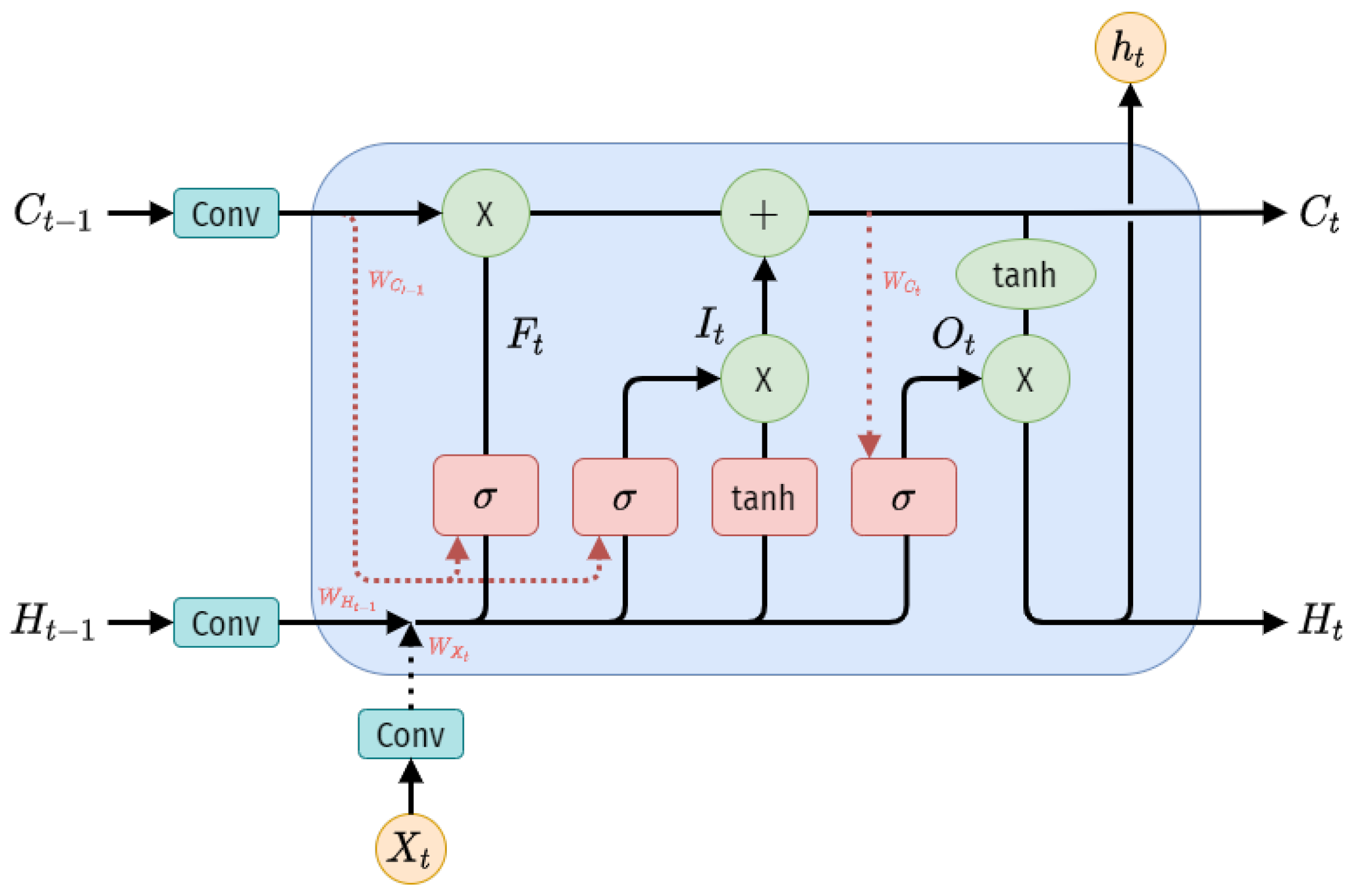
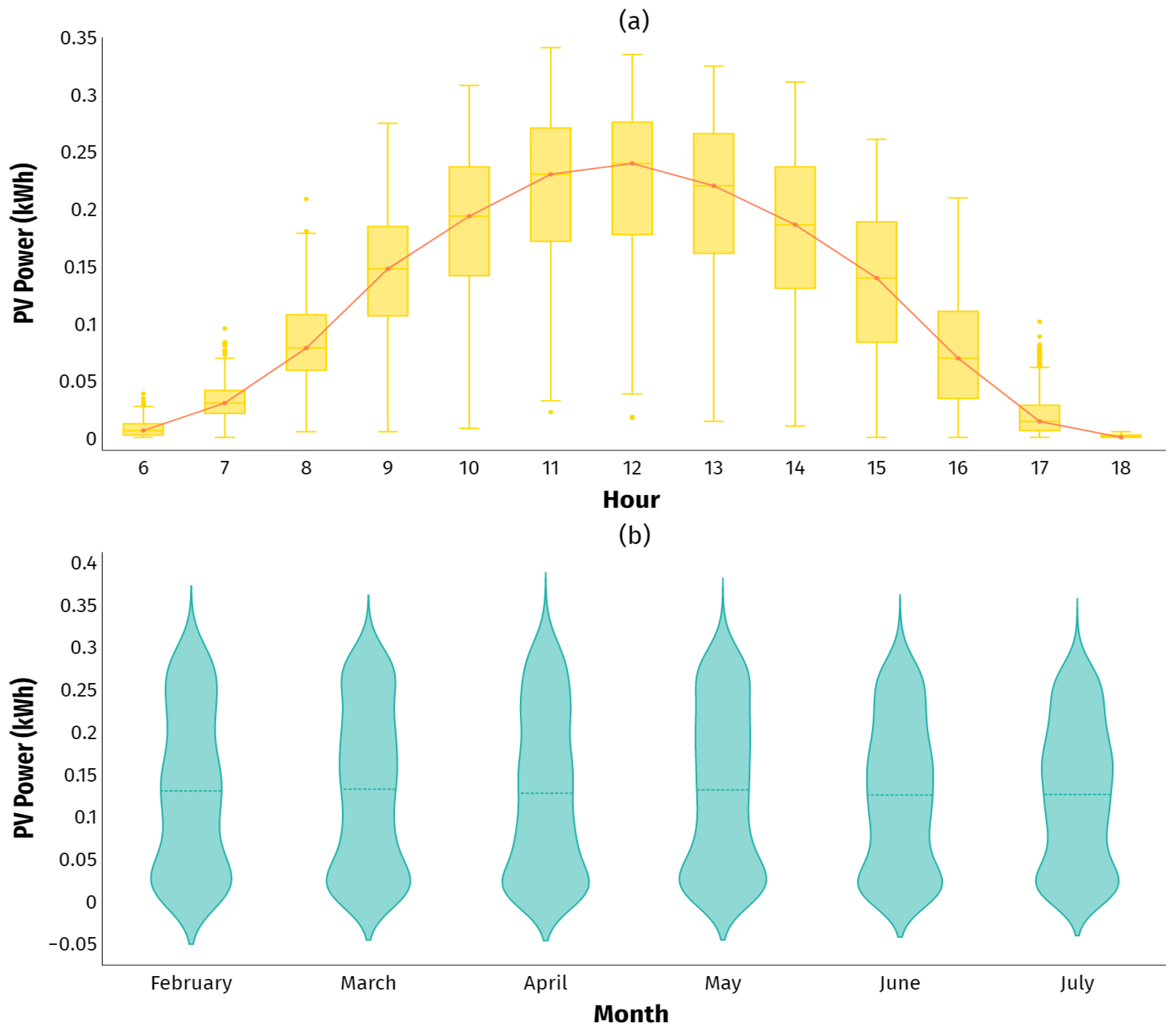
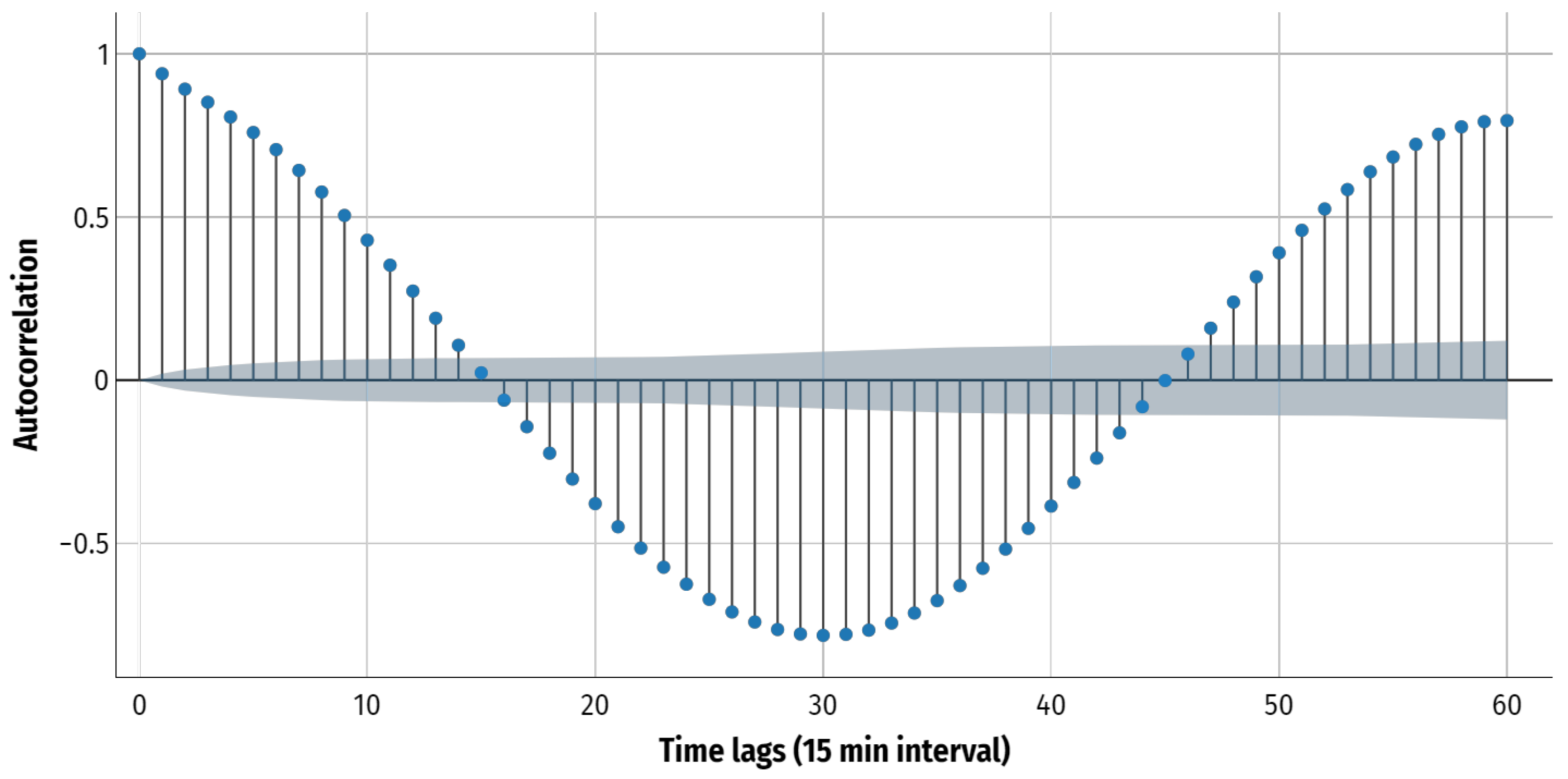


| Ref. | Input Data | PV Cap. | Scalability | Data | Model |
|---|---|---|---|---|---|
| Analysis | Availability | Presented | |||
| [14] | PV power | 3 kW | M | 36 months | LSTM |
| (30 min res) | ConvLSTM2D | ||||
| [40] | PV power | 5 kW | M | 72 months | CNN |
| (15 min res) | CNN-LSTM | ||||
| [42] | PV power | 15 kW | M | 14 months | CNN-LSTM |
| Irradiance | (1 h res) | ConvLSTM2D | |||
| [43] | PV power | 20 kW | H | 37 months | ALSTM |
| Temperature | (7.5 min res) | ||||
| [44] | Irradiance | NS | L | 21 months | CNN+GAN |
| (15 min res) | |||||
| [45] | PV power | 10 kW | H | 13 months | SVR |
| (1 h res) | |||||
| [46] | Sun angles | 4.5 kW | M | XGB | |
| Irradiance | 12 months | ||||
| Cloud cover | (1 h res) | RF | |||
| Temperature |
| ML Technique | Hyperparameter | Value |
|---|---|---|
| SVR | C | 0.12 |
| 0.01 | ||
| kernel | “rbf” | |
| XGB | learning rate | 0.15 |
| n_estimators | 600 | |
| max_depth | 6 | |
| RF | n_estimators | 600 |
| max_depth | 5 |
| DL Technique | Hyperparameter | Value |
|---|---|---|
| MLP | Hidden layers | 3 (dense) |
| Neurons | (60, 60, 30) | |
| Learning rate () | 0.001 | |
| Hidden layer activation function | (`relu’, `relu’, `relu’) | |
| Vanilla LSTM | Hidden layers | 1 (LSTM cell) |
| Units | 60 | |
| Learning rate () | 0.001 | |
| Activation function | `tanh’ | |
| Stacked LSTM | Hidden layers | 3 (LSTM cell) |
| Units | (60, 60, 30) | |
| Learning rate () | 0.001 | |
| Activation function | (`tanh’, `tanh’, `tanh’) | |
| ConvLSTM | Hidden layers | 3 (ConvLSTM1D cell) |
| Units | (60, 60, 30) | |
| Learning rate () | 0.001 | |
| Activation function | (`tanh’, `tanh’, `tanh’) |
| Forecasting Horizon | Model | RMSE (kWh) | MAE (kWh) | MAPE (%) | |
|---|---|---|---|---|---|
| 15 min ahead | SVR | 0.0263 | 0.0143 | 0.9014 | 18.87 |
| XGB | 0.0263 | 0.0131 | 0.9021 | 14.39 | |
| RF | 0.0251 | 0.0121 | 0.9104 | 14.49 | |
| MLP | 0.0262 | 0.0127 | 0.9029 | 14.06 | |
| Vanilla LSTM | 0.0259 | 0.0122 | 0.9050 | 14.57 | |
| LSTM | 0.0261 | 0.0123 | 0.9039 | 14.02 | |
| ConvLSTM1D | 0.0264 | 0.0125 | 0.9015 | 14.38 | |
| 30 min ahead | SVR | 0.0288 | 0.0159 | 0.8822 | 21.99 |
| XGB | 0.0287 | 0.0145 | 0.8838 | 17.41 | |
| RF | 0.0274 | 0.0134 | 0.8937 | 16.91 | |
| MLP | 0.0279 | 0.0138 | 0.8901 | 16.30 | |
| Vanilla LSTM | 0.0285 | 0.0137 | 0.8849 | 16.55 | |
| LSTM | 0.0287 | 0.0139 | 0.8838 | 16.45 | |
| ConvLSTM1D | 0.0273 | 0.0135 | 0.8855 | 16.28 | |
| 1 h ahead | SVR | 0.0318 | 0.0179 | 0.8567 | 25.70 |
| XGB | 0.0307 | 0.0157 | 0.8663 | 20.20 | |
| RF | 0.0296 | 0.0149 | 0.8760 | 19.67 | |
| MLP | 0.0304 | 0.0153 | 0.8691 | 17.85 | |
| Vanilla LSTM | 0.0304 | 0.0152 | 0.8693 | 18.54 | |
| LSTM | 0.0314 | 0.0155 | 0.8601 | 17.14 | |
| ConvLSTM1D | 0.0275 | 0.0134 | 0.8898 | 17.65 |
| Approach | XGB (USD) | RF (USD) | SVR (USD) | MLP (USD) | Vanilla (USD) | LSTM (USD) | ConvLSTM (USD) |
|---|---|---|---|---|---|---|---|
| Risk neutral | 0.65 | 0.60 | 0.71 | 0.63 | 0.61 | 0.61 | 0.62 |
| Risk averse | 1.31 | 1.22 | 1.31 | 1.30 | 1.29 | 1.30 | 1.31 |
| Approach | XGB (USD) | RF (USD) | SVR (USD) | MLP (USD) | Vanilla (USD) | LSTM (USD) | ConvLSTM (USD) |
|---|---|---|---|---|---|---|---|
| Risk neutral | 0.78 | 0.74 | 0.89 | 0.76 | 0.76 | 0.77 | 0.67 |
| Risk averse | 1.53 | 1.47 | 1.58 | 1.51 | 1.51 | 1.56 | 1.37 |
Disclaimer/Publisher’s Note: The statements, opinions and data contained in all publications are solely those of the individual author(s) and contributor(s) and not of MDPI and/or the editor(s). MDPI and/or the editor(s) disclaim responsibility for any injury to people or property resulting from any ideas, methods, instructions or products referred to in the content. |
© 2023 by the authors. Licensee MDPI, Basel, Switzerland. This article is an open access article distributed under the terms and conditions of the Creative Commons Attribution (CC BY) license (https://creativecommons.org/licenses/by/4.0/).
Share and Cite
Cantillo-Luna, S.; Moreno-Chuquen, R.; Celeita, D.; Anders, G. Deep and Machine Learning Models to Forecast Photovoltaic Power Generation. Energies 2023, 16, 4097. https://doi.org/10.3390/en16104097
Cantillo-Luna S, Moreno-Chuquen R, Celeita D, Anders G. Deep and Machine Learning Models to Forecast Photovoltaic Power Generation. Energies. 2023; 16(10):4097. https://doi.org/10.3390/en16104097
Chicago/Turabian StyleCantillo-Luna, Sergio, Ricardo Moreno-Chuquen, David Celeita, and George Anders. 2023. "Deep and Machine Learning Models to Forecast Photovoltaic Power Generation" Energies 16, no. 10: 4097. https://doi.org/10.3390/en16104097
APA StyleCantillo-Luna, S., Moreno-Chuquen, R., Celeita, D., & Anders, G. (2023). Deep and Machine Learning Models to Forecast Photovoltaic Power Generation. Energies, 16(10), 4097. https://doi.org/10.3390/en16104097







